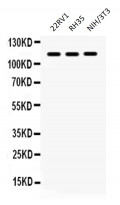ARG59461
anti-NLRC4 / CARD12 antibody
anti-NLRC4 / CARD12 antibody for Western blot and Human,Mouse,Rat
NLRC4 Inflammasome Study antibody
Overview
| Product Description | Rabbit Polyclonal antibody recognizes NLRC4 / CARD12 |
|---|---|
| Tested Reactivity | Hu, Ms, Rat |
| Tested Application | WB |
| Host | Rabbit |
| Clonality | Polyclonal |
| Isotype | IgG |
| Target Name | NLRC4 / CARD12 |
| Antigen Species | Human |
| Immunogen | Synthetic peptide corresponding to aa. 838-874 of Human NLRC4 / CARD12. (KILAQNLHNLVKLSILDLSENYLEKDGNEALHELIDR) |
| Conjugation | Un-conjugated |
| Alternate Names | CLAN; AIFEC; IPAF; CLANA; CARD12; CLANC; CLANB; CLAND; NLR family CARD domain-containing protein 4; Caspase recruitment domain-containing protein 12; Ipaf; CLR2.1; CARD, LRR, and NACHT-containing protein; CLAN1; Ice protease-activating factor; Clan protein; FCAS4 |
Application Instructions
| Application Suggestion |
|
||||
|---|---|---|---|---|---|
| Application Note | * The dilutions indicate recommended starting dilutions and the optimal dilutions or concentrations should be determined by the scientist. |
Properties
| Form | Liquid |
|---|---|
| Purification | Affinity purification with immunogen. |
| Buffer | 0.9% NaCl, 0.2% Na2HPO4, 0.05% Sodium azide and 5% BSA. |
| Preservative | 0.05% Sodium azide |
| Stabilizer | 5% BSA |
| Concentration | 0.5 mg/ml |
| Storage Instruction | For continuous use, store undiluted antibody at 2-8°C for up to a week. For long-term storage, aliquot and store at -20°C or below. Storage in frost free freezers is not recommended. Avoid repeated freeze/thaw cycles. Suggest spin the vial prior to opening. The antibody solution should be gently mixed before use. |
| Note | For laboratory research only, not for drug, diagnostic or other use. |
Bioinformation
| Database Links | |
|---|---|
| Gene Symbol | NLRC4 |
| Gene Full Name | NLR family, CARD domain containing 4 |
| Background | NLRC4 / CARD12 is a member of the caspase recruitment domain-containing NLR family. Family members play essential roles in innate immune response to a wide range of pathogenic organisms, tissue damage and other cellular stresses. Mutations in this gene result in autoinflammation with infantile enterocolitis. Alternative splicing results in multiple transcript variants. [provided by RefSeq, Oct 2014] |
| Function | NLRC4 / CARD12 is a key component. of inflammasomes that indirectly senses specific proteins from pathogenic bacteria and fungi and responds by assembling an inflammasome complex that promotes caspase-1 activation, cytokine production and macrophage pyroptosis (PubMed:15107016). The NLRC4 inflammasome is activated as part of the innate immune response to a range of intracellular bacteria. [UniProt] |
| Cellular Localization | Cytoplasm. Cytoplasm, cytosol. Note=Cytoplasmic filaments. [UniProt] |
| Highlight | Related products: NLRC4 antibodies; NLRC4 Duos / Panels; Anti-Rabbit IgG secondary antibodies; Related news: Exploring Antiviral Immune Response |
| Research Area | NLRC4 Inflammasome Study antibody |
| Calculated MW | 116 kDa |
| PTM | Phosphorylated at Ser-533 following infection of macrophages with S.typhimurium (Salmonella). Phosphorylation is essential for NLRC4 inflammasome function to promote caspase-1 activation and pyroptosis. PRKCD phosphorylates Ser-533 in vitro (By similarity). [UniProt] |
Images (1) Click the Picture to Zoom In






